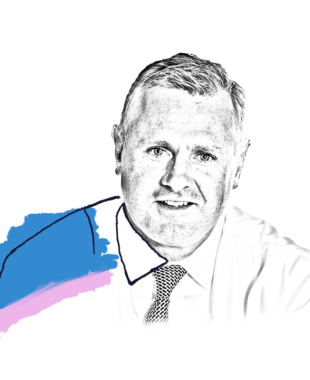In this article, Executive Director Roy Leckie highlights that while the current turbulent equity environment is presenting near-term hurdles, it is important to focus on the long term. Many of the world’s best companies are successfully navigating the current challenges and remain well positioned for the future.
The prospect of higher interest rates against a backdrop of stubborn inflation and rising global political tensions have blighted the start to the year in equity markets, with a variety of hitherto strongly performing sectors posting sharp declines from recent highs. Valuation compression has been quite marked in several of these sectors, with information technology bearing the brunt of the downdraught. In contrast, ‘spread’ trades, such as financials, have been resilient, and energy stocks have been strong as oil and gas prices ratchet higher.
Since the Global Financial Crisis of 2008, monetary laxity has almost been a given in the investor psyche, with cheap money being a ‘Band-Aid’ at times of economic stress. Even with the recent falls, markets have rebounded significantly from the lows of early 2020, and the potential reset of interest rates in the US in particular is raising concerns that a less-benign monetary environment will remove what has been a supportive factor in equity market performance and valuations. How far inflation and the Federal Reserve response goes remains to be seen. Fed chairman Jerome Powell no longer considers inflation as transitory, but there remains the belief that some of the current inflationary pressures will recede as supply and demand mismatches are resolved.
The shift in monetary policy should be seen in the context of a US economy that has been recovering strongly from the depths of the pandemic, as evidenced by the 6.9% year-on-year rise in GDP in the fourth quarter of 2021. While the 7.5% year-on-year surge in the Consumer Price Index in January reflects supply and demand imbalances and a tight labour market, it also speaks of economic vigour. Despite lacklustre growth in Germany, where the manufacturing sector has been impacted by supply chain issues, Europe has been staging a firm recovery, although inflation continues apace in the region. So far, the European Central Bank has resisted doing a volte face on altering interest rates, remaining of the view that maintaining economic momentum is more important than tackling what it views as short-lived inflation, despite growing expectations that its hand will eventually be forced.
While world economies continue to emerge from under the pandemic veil, albeit unevenly, there remain many counter currents that will shape the market tone in 2022
The Bank of Japan is seeing a pickup in economic momentum and inflation as the country shakes off the Covid shackles, although with expectations that consumer prices will rise a meagre 1.1% in the coming fiscal year, monetary stimulus remains the order of the day. With China de-emphasising the property sector as an engine of growth at a time when it is conducting a harsh ‘zero-Covid’ containment policy, the People’s Bank of China has cut interest rates to help reinvigorate the slowing economy.
However, while world economies continue to emerge from under the pandemic veil, albeit unevenly, there remain many counter currents that will shape the market tone in 2022. Central banks might be left woefully ‘behind the curve’ in terms of inflation if supply and demand mismatches are slow in being resolved. Should they decide to ram the inflation genie back in its bottle through more aggressive-than-expected tightening, this would provide a recipe for further market volatility. And there exists the scope for policy error should they overdo it. Incomes not keeping up with pernicious price rises (energy price hikes are not helping), over an extended period would not be good news for consumption, a major engine of economic growth. Investors may increasingly fret over the impact of this environment on corporate top lines, anxious about the continued ability of companies to weather demand pressures and cope with rising costs. Additionally, heightened global political tensions may further fray investors’ nerves.
Markets are currently going through the pains of being weaned off cheap money
This might appear to be a somewhat dour prognosis for the equity environment. However, economies are continuing to grow, as are corporate earnings. Cash levels, as demonstrated by M&A deals and private equity funding, remain high. The prospect of an alleviation of supply chain issues, and a still-respectable rate of economic expansion with a modest and appropriate rise in interest rates would represent a reasonable backdrop for equities. However, markets are currently going through the pains of being weaned off cheap money, and it looks like inflation may settle at a higher rate than has been the case in recent decades.
That said, our investment process is not founded on taking any macroeconomic views. Current events have not solicited a change in investment approach on the part of the Research team. We are sticking to fundamentals, looking for market-leading, financially robust companies, able to deliver strong earnings growth over the long term, as they take advantage of or indeed create trends that will drive their businesses for years to come. Whatever near-term equity market turbulence, in the long run it is earnings growth that drives share prices.
Adaptability and resilience remain a feature of many of these businesses
So rather than trying to weigh up variables over which we have no control, we have been analysing and assessing how leading companies are navigating through the current challenges and how they are positioning themselves for the future. Adaptability and resilience remain a feature of many of these businesses. Looking at recent earnings announcements, they are benefiting from recovery, adapting well to higher costs, enhancing productivity, and flexing their pricing muscles in the current environment.
Having powerful and durable growth drivers help insulate businesses from the impact of cyclical or structural inflation, while market-leading companies with a strong brand or franchise are able to enjoy the benefits of pricing power. Higher inflation may be an incremental nominal growth driver as businesses pass through cost increases – either because they are contractually entitled to do so, or their competitive position enables them to raise prices. Many of these companies may also be able to pass through ‘inflation-plus’ pricing, thereby generating growth in real terms.
It is also the case that inflation itself can be a driver of growth as it encourages businesses to improve efficiency to the benefit of, for example, automation companies or vendors of productivity tools. Financial strength is also a hallmark of high-quality, leading companies, and is of particular relevance in an inflationary environment. Robust balance sheets and high profit margins can cushion the blow from rising costs, while conservative levels of debt means that companies are less impacted by rising interest rates. These attributes are evident in many of the world’s leading businesses and give us confidence in the ability of these best-in-class companies to navigate the challenges of inflation and deliver excellent long-term earnings growth.
Leading companies are positioning themselves well for future growth
Granted, the slew of good earnings results represents historical events and there are many hard acts to follow earnings-wise across sectors, but there is plenty of evidence that leading companies are positioning themselves well for future growth. And while the current valuation compression is painful, it is also providing opportunities for the patient investor able to take a long-term view.
Even with the recent setbacks, equity markets have travelled a long way and 2022 may prove to be a challenging year given the economic and geopolitical uncertainty. There may be periods of volatility in share price performance, but our confidence in the ability of many financially strong, market-leading companies to deliver robust profit growth over the long term remains high. Investing in the world’s best businesses and allowing the power of compounding to do the rest represents a compelling proposition for investors in our view.
Important Information
This article is provided for general information only and should not be construed as investment advice or a recommendation. This information does not represent and must not be construed as an offer or a solicitation of an offer to buy or sell securities, commodities and/or any other financial instruments or products. This document may not be used for the purpose of an offer or solicitation in any jurisdiction or in any circumstances in which such an offer or solicitation is unlawful or not authorised.
Stock Examples
The information provided in this article relating to stock examples should not be considered a recommendation to buy or sell any particular security. Any examples discussed are given in the context of the theme being explored.


